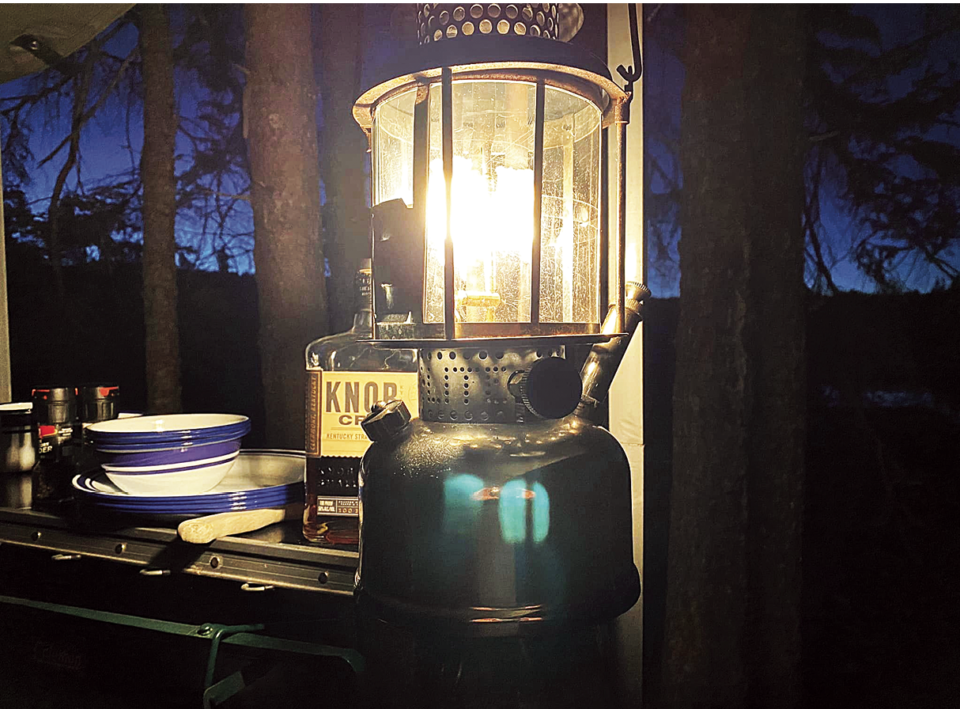The soft light, warm glow and gentle hum of a gas lantern burning in the night has captivated our primitive needs for generations. Everybody understands—you’re in the woods, it’s nighttime, it’s dark—you’ve got to have your own autonomous lighting out there. It’s human instinct to want the safety and security of illumination.
But for Damian Wilmot, of Superior WI, one specific lantern—the Coleman gas lantern—is the pinnacle of cool. In fact, Wilmot’s appreciation and respect for the Coleman lantern has led to somewhat of an addiction for collecting vintage models. Wilmot collects lanterns the way other people might collect art. He treasures every piece, and puts valuable time and attention into restoring each lantern to its rightful beauty. Wilmot ignores today’s plethora of battery-powered, rechargeable LED headlamps and lanterns, giving preference instead to the “timeless” gas Colemans.
He’s not joking about the timeless part—Wilmot’s collection of 65 lanterns (and growing) is largely based around Coleman models made in the 1920s. For Wilmot, the older—the better. But how did he get started collecting the lanterns?
“I’ve always had Coleman gas lanterns, starting from my Boy Scout days as a teenager,” says Wilmot. “Then, about 25 years ago, I stopped at a rummage sale, and they had an old Coleman lantern there for five bucks. I’d never seen one that looked like that—it looked really old and super cool. So, I grabbed it, but I never really did get it running. Then, about six years ago, a friend posted some photos of an old Coleman lantern with a nickel-plated fount, like the one I had standing on my fireplace mantel. I sent him a couple photos of my lantern, and asked ‘Is this something you would like to get going for me?’ He texted me right back and said ‘Yah, that’s a Coleman 427. It was made in October of 1926.’ The next time he came up here fishing, he took it and got it running again, and that sparked my interest as a collector.”

Wilmot is deep into his collection.
“There are people who are far more insane about collecting these things than I am. But I do have one of the largest collections for our area,” he says.
He uses them too—he brings at least two lanterns on each camping trip, and rotates through his collection trip to trip. These are vintage lanterns from the 1920s, 30s and 40s, and they still run, thanks to the love and care that Wilmot gives them. Wilmot also has an off-the-grid cabin on the Brule River, where he spends every Friday, Saturday and Sunday night. The lanterns are his only source of light there. So, all of his 65 pieces make the rotation at some point in the cabin season.
Wilmot’s goal is to get every one of his 80 to 100-year-old vintage lanterns operating in peak condition again, stating that he has “no interest in lanterns that don’t work.” Once he finds a vintage lantern for sale, Wilmot cleans it.
“They’re really a simple apparatus. If a Coleman lantern isn’t burning correctly, it’s one of three things—either the generator, the fuel pick-up, or the air tube is clogged. You can just pull them apart and inspect. I’ll soak the parts in vinegar overnight. That literally solves most of the issues.”
Wilmot enjoys the simplicity of the lanterns’ operation.
“They need fuel and air to burn. If they’re not burning correctly, fuel and air are your only problems. For a lot of the lanterns, starting from the 220B series, you can still go to Northwest Outlet in Superior and buy a generator off the shelf. The generator has been the same for the last 80 years.”
Coleman sells new gas lanterns today for $115 apiece on their website. You will also need a gallon of Coleman white gas, which runs around $18, and can be bought at any hardware store. Coleman also makes cheaper lanterns today that run off its ubiquitous propane cartridges, but Wilmot collects only the gas lanterns and he isn’t done collecting yet.
“There are definitely lanterns I’d still like to get my hands on, but I’m a lot more discerning now. Some lanterns are relatively common, like the 228F (model from the 1960s). Coleman made millions of those. So, unless it’s a nicer example than what I already have, I tend to pass on it.”
Wilmot says he’s also cleaned and shined up a number of lanterns, and gotten them working correctly, in order to give them to friends.
Note to readers with old lanterns hanging around in their basements—Wilmot says the glass globes alone can go for $75 on eBay, if they’re rare varieties. The correct, original globes add the special touch to old lanterns, and Wilmot has been known to buy a rummage sale lantern just to source the globe.
For those of you with old Coleman lanterns lying around that you want to reincarnate, another resource may be the website: oldcolemanparts.com.
Today, with gas lanterns falling out of favor to lightweight, battery-powered LED lanterns, Wilmot feels a nostalgia for the craftsmanship of old.
“It’s sad, but the white gas lantern is really kind of a relic now. The lanterns of the 50s, 40s, 30s were beautiful. They were literally hand-crafted and polished. They were mass produced, but they don’t have a mass-produced look.”
Wilmot philosophically compares Coleman lanterns to firearms, saying, “One of the things that makes these lanterns so cool to me is that they’re like guns. When you look at the original modern firearms designers, like Samuel Colt, John Browning and Paul Mauser, and what they did in the 1800s, here we are 150 years later, and nobody’s really changed what those guys did. The delivery method for a bullet has not changed significantly all these years. William Coleman came up with his lantern design in 1911, and it’s remained essentially the same for 110 years. It’s a beautiful design. It’s cool that the design has stood the test of time.”
This continuity clearly appeals to Wilmot and his personal Coleman collection is a show of respect for this timelessness.




